
The Man Behind Snow White And The Seven Dwarfs
A vintage peek inside the Disney Studios production of this animated classic, shot in Technicolor one frame at a time.
Photos by Len Weissman
Once upon a time, as old Jakob Grimm used to say in telling his tales, there was a newsreel cinematographer. His name was Walter Ellis Disney, and he lived in Kansas City, where he filmed news stories for Pathé, Selznick and most of the other silent-day newsreels. In addition to grinding a camera, cinematographer Disney liked to draw. Eventually he harnessed his camera and his pencil together, and began to make animated cartoons.
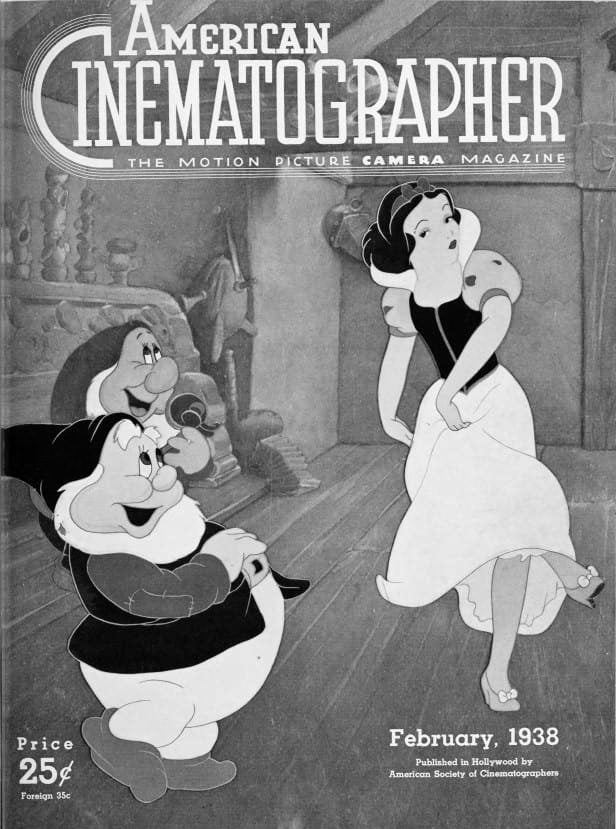
A dozen years later, in Hollywood, this same Walt Disney is still making animated cartoons. Whenever and wherever there are awards or honors offered for outstanding achievement in making animated films, Disney smilingly steps up and annexes them as a matter of course. Throughout the lengthening history of the Academy Awards the golden statuette for the best in cartoon films has never been bestowed on any other producer.
The intervening years have changed animated cartoons — and particularly the Disney cartoons — almost beyond recognition, but they have not touched Walt Disney. He is still the same, breezy, informal fellow who used to grind out news films for Pathé, and between times sketched amusing caricatures of the office mouse.
Unique Studio
Today, however, he is the head of the industry’s most unique major studio; a plant where over 300 men and women labor enthusiastically to transform fantasy into tangible Technicolor that can be viewed on the world’s screens. A plant where the most delicate, fairy-tale fantasy is joined to the intricate, slide-rule mathematics of cinematic engineering. A plant where, above all, each of the 300 workers functions like an extension of Walt’s hands and mind.
For despite this huge force, the Disney Studio is essentially a one-man organization. Every detail passes in some fashion through his hands, and every decision, no matter how small, receives his personal attention.
Not that there is anything stuffily formal about it! It is a simple and natural tribute to the man whose genius is inevitably the inspiration of everything done by his co-workers.
As one of them expressed it, “There isn’t a single operation in the plant at which, in a pinch, Walt couldn’t step in and carry on acceptably himself. Perhaps, in some of the more intricately technical ones, he couldn’t do as perfect a job as the men who are now doing it; but understand this, he could still do it — and do it better than average well.”
Disney’s intimate contact with every detail of his studio’s work may partly explain why none of his hundreds of employees would dream of ever addressing him or referring to him by the formal title of “Mister.” For a Disney worker to call his chief anything but Walt would be as inconceivable as an ordinary studio employee addressing his boss as Darryl or Louie.
Disney’s features, like the age-old tales from which they spring, will, unlike much contemporary production, be as appealing to audiences of all ages, races and creeds 100 years from now as they are today.
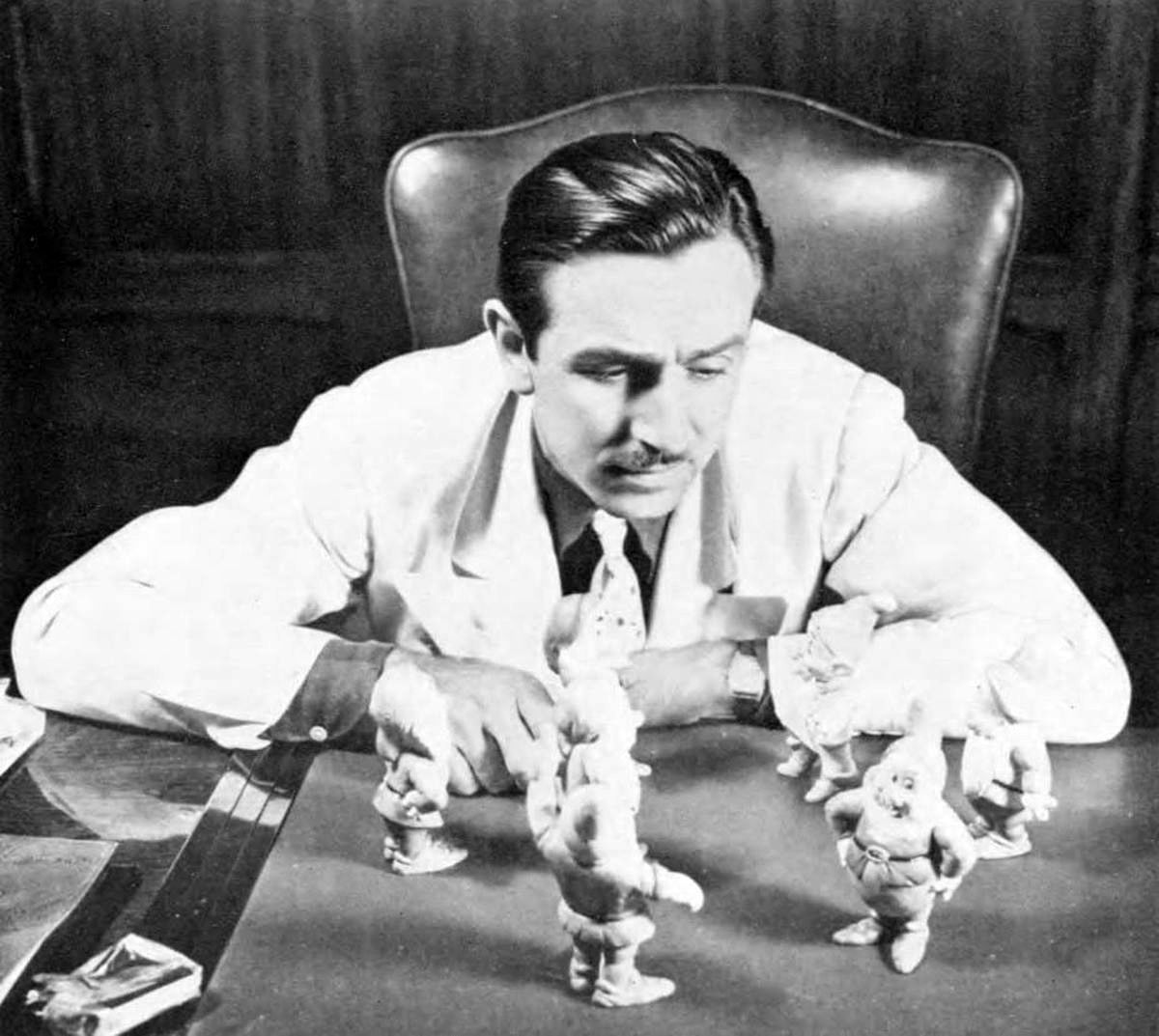
No Time Clock Here
In passing, it may be mentioned that there is no such thing as a time clock in the Disney Studio. If Walt has his way there will never be one, for he and his associates work, not for pay checks or profits, but because they believe in what they are doing and because they love it.
And let it be recorded here and now that making a Disney cartoon — whether it be done of the short “Mickey Mouse" and “Silly Symphony” reels which emerge at two or three week intervals, or a feature like Snow White and the Seven Dwarfs — is work, often in the more laborious sense of the word.
Most of us, when we think at all of how animated cartoons are made, think of it in relatively simple terms: backgrounds sketched on paper, animated action on celluloids, with the several drawings superimposed and photographed, a frame at a time, with the animating “cells” changed between each frame or two. A tedious operation, perhaps, drawing and photographing the several thousand frames that constitute a one-reel short, but essentially simple.
That is still the basic principle of operations in Disney’s “mouse factory,” but in advancing the animated film to its present state of technical and artistic refinement, Disney and his staff have added so unbelievably to these fundamentals that they are buried in an incredible profusion of technicalities. The starting point of any picture is of course the story. In the case of Snow White it was of course Jakob Grimm’s century-old fairy tale; in the two features currently in production, Pinocchio and Bambi equally familiar books furnished the inspiration. In the short subjects, the story originates from an idea.
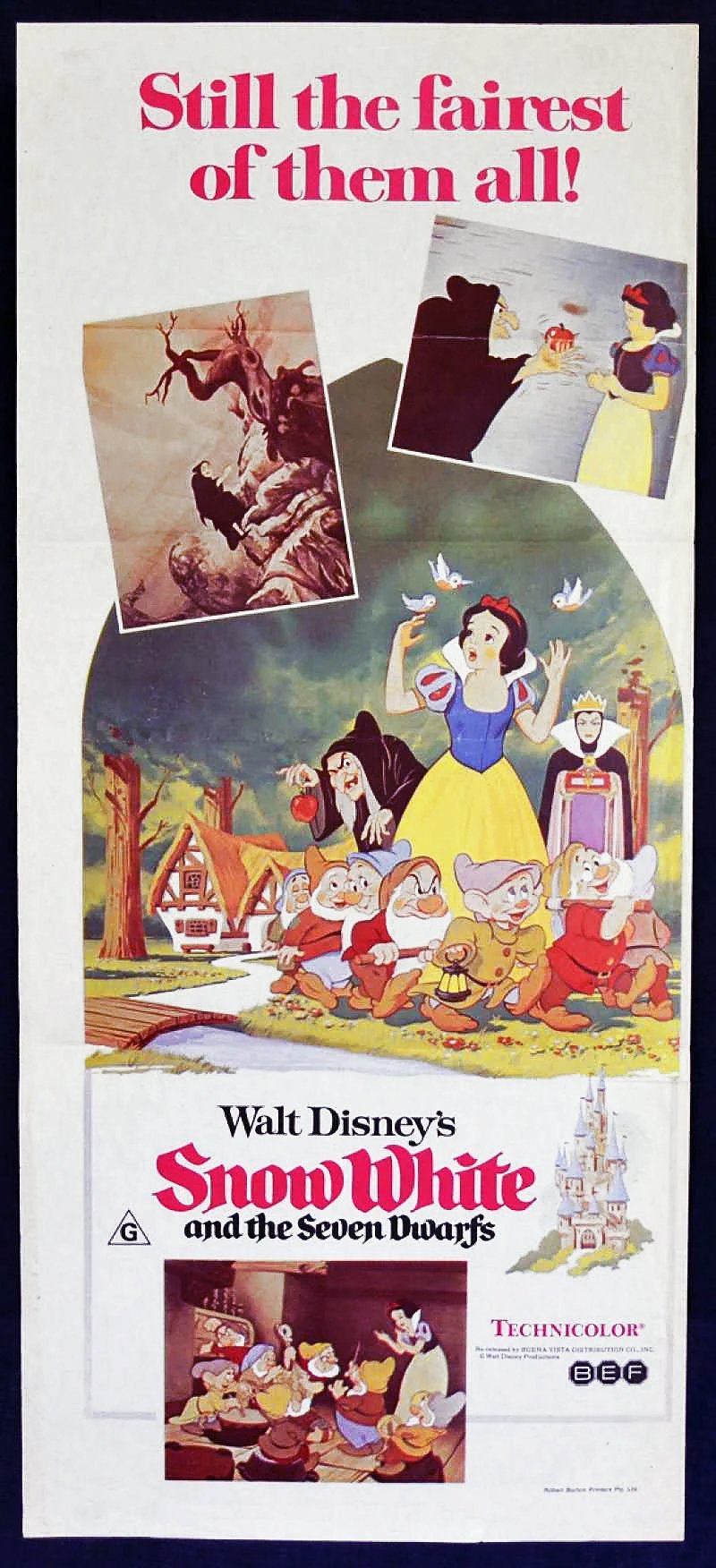
Start With Just Idea
Perhaps it is an idea from Walt’s fertile brain or from one of his story staff; perhaps it is simply a suggestion made by someone in or about the studio.
Whatever it is, Walt and his story drawing “writers” confer over it, tearing it apart, building it up, adding, deleting, changing and revising until the story outline, supported by sketches of key scenes and characters, stands complete, perfectly adapted alike to the cartoon medium and to Disney’s unique interpretation of it.
The story is then turned over to a corps of unit animators. Each of these directs the drawing of certain definite sequences. Each may draw the key drawings — the beginnings and ends of movements, and such basic features — while other animators complete the innumerable “in-between” drawings necessary. Still other artists draw backgrounds exclusively.
While this is being done, the music, songs, dialogue and sound effects are written and recorded. This is necessary due to the essentially rhythmic nature of all Disney films, and, especially in the features, to the necessity for accurately synchronizing the pictured lip-movements with the recorded words.
When the sound is recorded the sound experts “read” the track, and can break down the words, rhythmic beats and so on into terms of film footage and frames. Thus they can tell the animators to draw Snow White or one of the dwarfs speaking a given word at a definite frame in the scene.
Animation Smooth
This gives the animator the key to the situation, for at such a frame the camera will be photographing a definitely numbered drawing. Thus, when the picture is photographed, it is already synchronized with the prerecorded sound, no matter how long before that sound was recorded. Some of the songs and dialogue for Snow White and the Seven Dwarfs actually were recorded nearly three years before the accompanying drawings were photographed.
Everyone who has seen Snow White has commented upon the incredibly smooth, lifelike quality of the animation. Part of this, as Walt and his cohorts freely admit, was achieved by the simple but painful method of trial and error. If a scene as originally made did not seem smoothly satisfactory, Walt with his artists and technicians studied it, analyzed it until they found what was wrong.
Then they made the whole thing over — drawings and all — often only to repeat the process as improvements showed room for further advances. This painstaking care was one of the factors which ran the costs on this production up from an estimated $250,000 to a rumored $1 million dollars, but, as the Disneyites repeatedly state, cost does not enter into consideration at Disney’s until perfect quality is assured.
Another vital factor in the perfection of Snow White’s animation is the guidance furnished by what Walt calls “live action.” Living actors, suitably costumed, are photographed going through the desired action. The films of this “live action” then guide the animator in preparing his drawings. Each animator works with a Moviola at his side. In this he can study the live action film both in motion, and frame-by-frame.
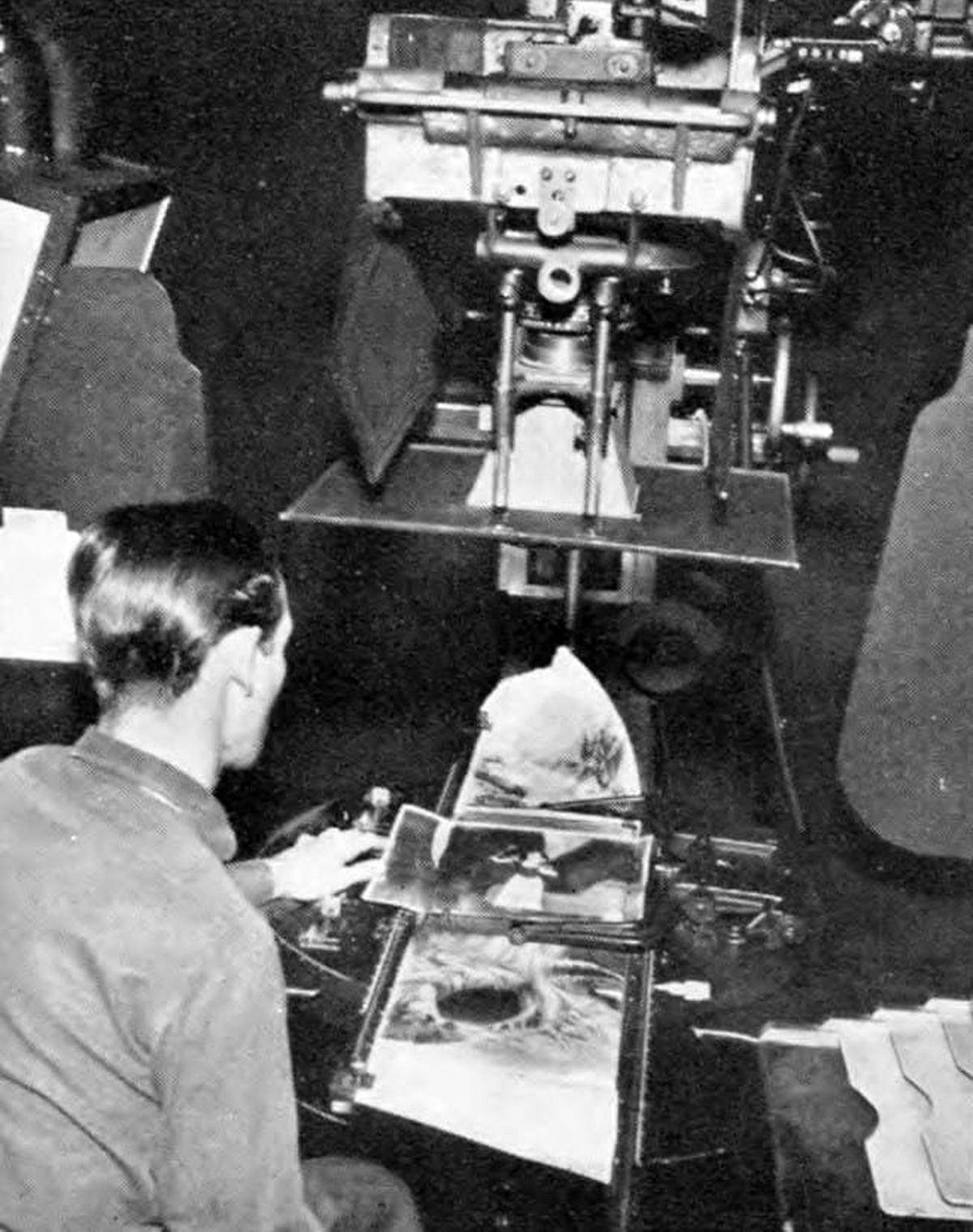
16mm Camera Enters
It has been rumored that the animated drawings are copied directly from this film; but such is not the case. The live action serves purely as a guide. Actually, it is pointed out, if the drawings were copied directly from the “live action” frames, the result, while mathematically accurate, would seem unnatural.
The proportioning of figures, heads, and so on, oddly enough, must be distorted and exaggerated in the cartoon — even for so natural a character as Snow White— if the result is to appear natural on the screen.
The genesis of this “live action” technique probably had its beginning some six years ago, when Walt purchased a 16mm camera for some vacation filming. At that time, writing in the American Cinematographer for March, 1932. Walt said:
When I bought my camera I intended to use it entirely for my own pleasure. But Mickey Mouse intervened. He always does! Ever since I first drew him he has become more and more real and like a real child, ingratiatingly demands more and more of my spare time. I had never expected that he would become interested in amateur moviemaking though!
But he fooled me, and did. I think it started while I was in St. Louis and visiting the wonderful zoo they have there. Something (it must have been Mickey) whispered into my ear and asked me if I didn’t realize how interesting it would be to have some films of the way the different animals and birds walked and flew, and how useful it would be in showing my animators how to draw them for the cartoons. “I didn’t pay too much attention to Mickey’s urgings, for after all, I was on a vacation. But I did unlimber the camera, and shot a number of rolls of the various birds and beasts, telling myself, however, that I was doing it because they were so interesting to me.
But when I got back to the studio, Mickey made me run the films for the animators, who got a number of ideas from them. Now I’m going to make some more films of the same sort, doing them more carefully, and in slow motion, so that we can really analyze the movements.
Slow Motion Factor
So extensively has this idea been developed that over 60 percent of Snow White and the Seven Dwarfs was animated with the guide of live-action filming. Today, such celebrated motion-picture directors as Sidney Franklin, director of Good Earth, and such notable cinematographers as James Wong Howe, ASC are on the Disney staff, helping to solve the problems of producing the cartooned features.
Another advantage offered by well-directed live action is pointed out by one of the animators, who remarked that the live action films help the artists to solve the ever-perplexing problems such as what to make an actor’s left hand do when his right hand is doing some important business, how to manage hands and feet while dialogue is spoken, or songs sung, and so on.
After all, a painter or illustrator uses live, if motionless, models; why shouldn’t the animated cartoon artist take advantage of live action film for modeling his animated drawing?
But even with the advantage of live action models, the animator depends largely on photographic tests of his actual drawings. When he has completed the original animations of a scene, sequence, or even of a single movement, he can send his drawings which, at this point, are simply pencil outlines on white paper, to the test department to be photographed.
Moviola Comes In
Here the drawings are photographed with an ordinary black-and-white camera, usually on recording-positive film spliced together from the Sound Department’s “NG’d” soundtrack takes. This film is developed in a miniature laboratory in the studio, and a few minutes later the artist can slip the test-negative into his Moviola and study his animation in motion.
These tests are invaluable in coordinating the work of the many individual artists who animate the scenes comprising a sequence. Consequently, the film is run and rerun, and spliced and re-spliced with tests of other parts of the action.
Since several frames are often lost with each new splicing, and since each scene has a very definite starting point, the film, as soon as it is developed, is marked with a special punch which punches a decreasing number of fine holes in each of the first six or eight frames.
Thus, even when the film has been spliced — and accordingly shortened — half-a-dozen times, anyone can immediately determine how many frames have been deleted.
Another technical development which played a great part in the smooth animation of Snow White and the Seven Dwarfs was one which permitted the animators to make their drawings in any size that may be convenient. Actually, in some of the long shots the drawn image of a figure like that of Snow White would be but half an inch or less in height.
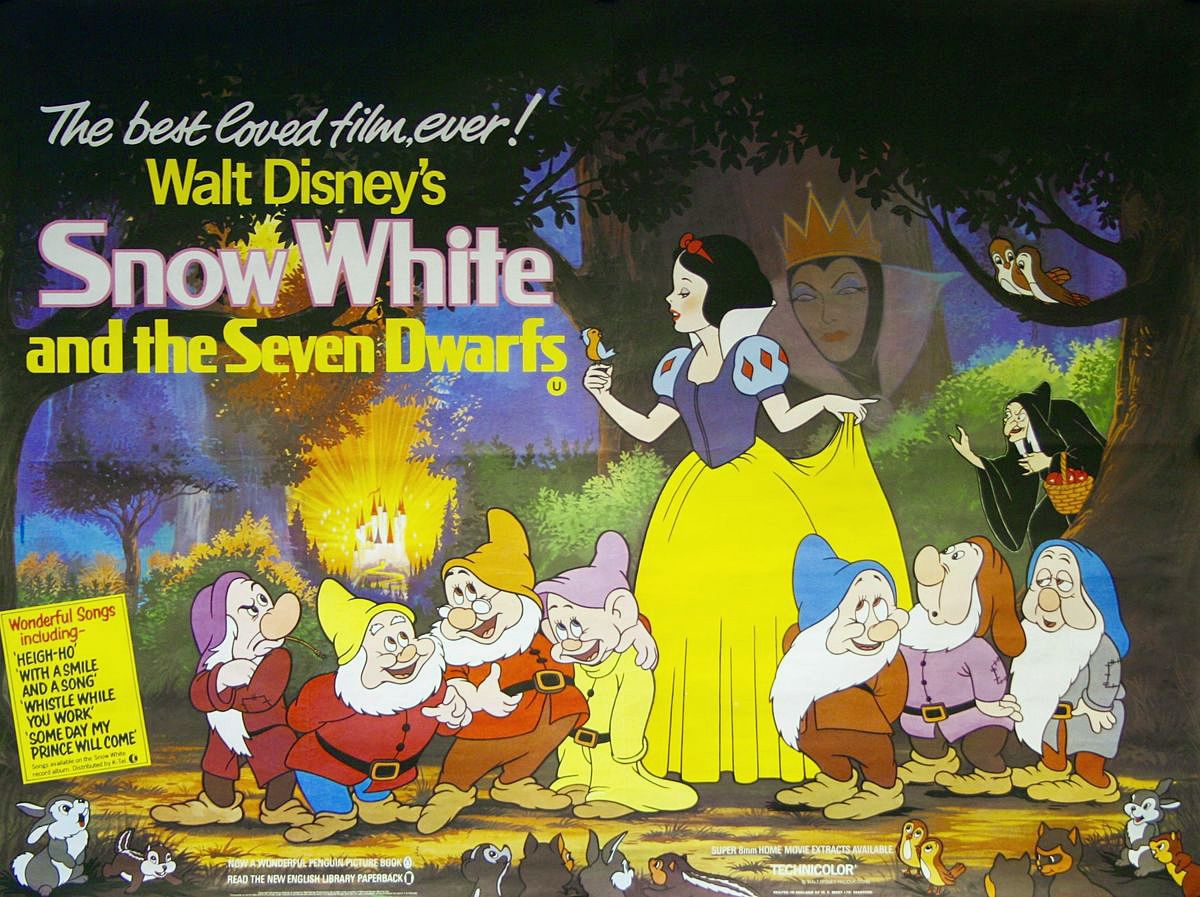
Scope for Artists
This would of course be far too small for accurate drawing, even if there was to be no animation. It would be absolutely impossible to secure smooth continuity of the successive drawings of this tiny figure in animated scenes, to say nothing of the impossibility of achieving uniformly smooth animation.
But in Snow White and the Seven Dwarfs the artists were able to draw these animations in any size they wished; they could make the figure eight, ten inches or a foot high if they desired, affording themselves ample scope for including the minutest detail, and for the smoothest consistency of line and animation.
These large drawings are then photographed, and the negative printed, with the necessary reduction in size, on Eastman “wash-off relief” films, 11 by 14 inches in size. These are then developed and tanned in the usual manner, but not, as would ordinarily be the case, colored and used for color printing.
Instead, the films, which show a strong brown outline image of the drawing, are fixed out and, exactly like any ordinary inked celluloid, are backed with the requisite colors and then used, like any ordinary “cell,” in photographing the cartoon.
Many of the most important scenes in Snow White and the Seven Dwarfs owe their perfection to this technique. Many, too, combined this with live action photography to result in animation which could not have been approached with the older, conventional methods of animation.
Finally, the painted backgrounds and the celluloid animations are photographed. This is a simple statement of what was once a routine operation, but by no means a simple one.
Filters Balanced
The camera used is a special one, which successively exposes three frames, each through the correct color filter to give the three necessary color separation negative frames for the three-color Technicolor process.
The filters used are mounted in a rotating disk which makes one revolution for each three frames of films exposed, thereby exposing one frame behind the blue filter, one behind the red, and the third behind the green. The filters, of course, are balanced with the proper neutral density increments to equalize the three exposures for a uniform exposure period.
For straightforward camerawork the backgrounds and cells are photographed in the usual way, with the background held on a flat base and the cells superimposed directly on top of it, and all held in register by accurate registering pegs which engage perforations in the celluloids, while a pneumatically operated glass pressure plate holds all flat.
But for special scenes, a special “Multiplane” camera is used. This is an immense stand which permits arranging the celluloids in as many as five or more separate planes above the background. It is possible to animate action on cells several inches or a foot above the painted paper background, while other action animates in yet another plane and painted “foreground pieces” between the animated cells and the camera add further to the illusion of depth.
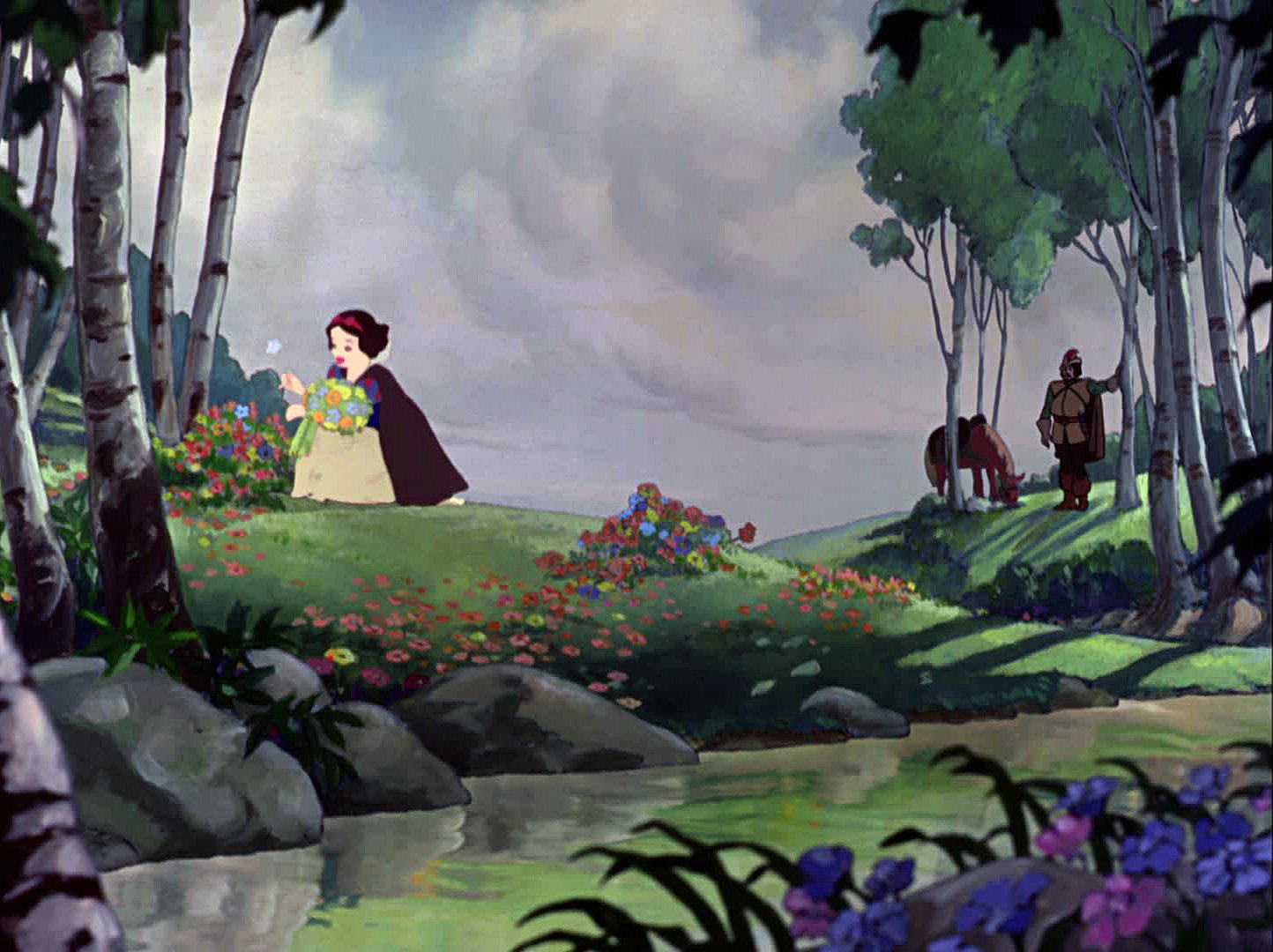
Essentially the principle is the same as that used for generations in the theatre, where a backdrop provides a background, and flats and cut — outs farther down stage in the wings suggest depth, while the actors move throughout the stage area.
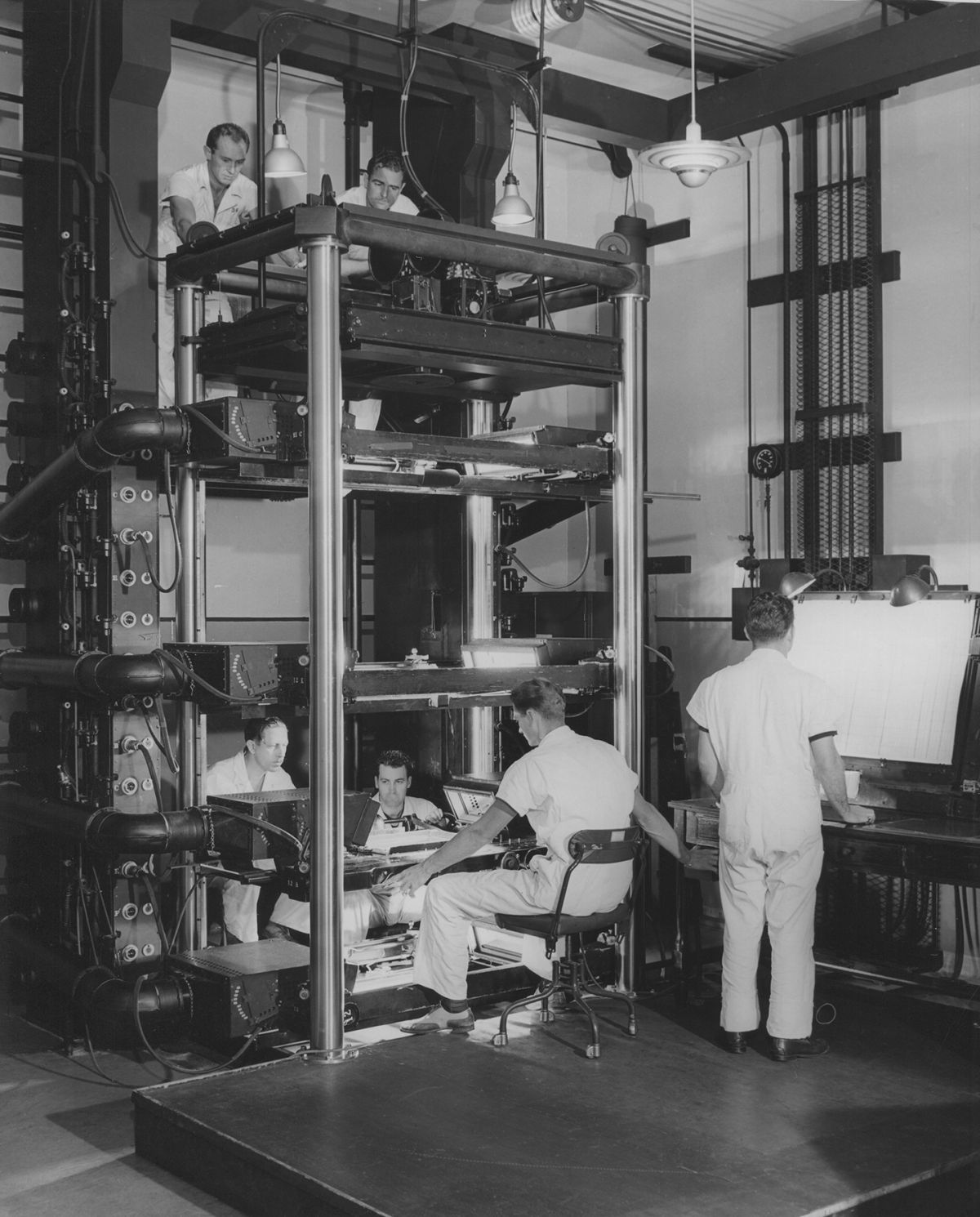
Movement Is Timed
The problems of perspective, proportions and timing in these multiplane scenes can be incredibly complex. Picture, for instance, a traveling shot in which the camera “follows” an animated character walking through a landscape.
In one plane the drawings (on celluloid) of the character would animate, following one scheme of perspective and timing. Behind him, the background would move past, not only in a different physical plane, but timed to an entirely different but necessarily rigidly proportioned degree of movement between exposures. In the foreground might be one, two or three sets of celluloids, perhaps animated, perhaps merely moving past, but proportioned and timed still differently.
The range of adjustments permitted by this intricate photographic set-up is incredible. Each of the stages is adjustable up and down along the camera’s optical axis, and may as well be swung in any direction laterally — north or south, east or west, as the Disney engineers phrase it.
The camera itself is susceptible to all of these adjustments, and may be rotated through a full 360-degree circle about the lens’ axis, as well. In all, camera, backgrounds, foregrounds and animated action are capable of no less than 64 separate and distinct adjustments for every frame exposed!
Two engineering graduates of the California Institute of Technology are kept constantly busy figuring out the mathematics involved in drawing and photographing these multiplane scenes. Thanks to their efforts the problems of actual photography are minimized.
The whole operation is charted on a special work sheet in which each horizontal column represents one frame and each vertical column the required setting of one possible movement of camera or celluloids. So many of the latter are required that each work sheet is more than three feet wide!
Two Crews
In operation one crew takes exclusive care of the camera’s adjustments and a separate crew is responsible for each of the various stages or planes being used for cells and backgrounds.
As each crew completes the adjustments required for a given frame of film, a button is pressed. This extinguishes the working lights on that plane, and signals on the master panel of the crew chief that that stage is ready. When all have reported ready, the chief presses the button which exposes the three negative frames which make one frame of technicolor positive.
Until this exposure is made, or until a special emergency release available only to the crew chief is pressed, none of the stages can turn on its working lights or alter the adjustment of their apparatus. As the exposure is made, a guide-ruler on the worksheet automatically drops down to the next horizontal column and things are made ready for exposing the next frame of film!
Ordinarily, when an animated cartoonist wishes to show a zoom or a trucking shot it would seem easiest merely to animate it in the drawings. But with Disney’s multiplane camera, and with the Disney insistence upon perfection in animation, perspective and the like, Walt’s crews make real trucking shots. By means of the carefully calibrated adjustments of the camera stand the camera can be dollied into or out of a drawn “set” as easily as one would dolly into a real set.
Another little complexity, explains Disney’s chief technical engineer, William Garrity, a Disney veteran of nearly a decade’s service, is the fact that in many scenes, to secure not only special effects, but such relative commonplaces as open shadows and the like, double and triple exposures are resorted to.
Believer in Research
Sometimes, special opaque mattes are used; at other times, the cells animating characters may be exposed once in the usual way, in front of the painted background, and then a second time against a flat black ground. The result is, as was seen in Snow White and the Seven Dwarfs, photographic quality that could not be obtained in any other way.
With such technical achievements as this to his studio’s credit and paying tangible dividends in the advances shown in Snow White, Walt is a firm believer in technical research. For some years a special section of the studio has been set aside as a practical proving ground for every idea or brainstorm occurring to Disney technicians.
From it came the multiplane camera and the use of the wash-off relief technique. It is now being reinforced by a formally constituted research staff, permanently devoted to delving into the possibilities of photographic and sound technique.
But the most amazing thing about the whole Disney enterprise is not the intricate technique, nor the way it is put to new and delightful artistic uses. It is, instead, Walt Disney’s personal attitude toward his epoch-making expansion into the feature producing field. Many successful producers of short subjects have approached the transition from shorts to features defiantly, or with ill-starred confidence. Walt, the industry’s most outstanding producer of short-length films, approached this inevitable step almost timidly.
He knew short-subject timing and action, but he admitted his ignorance of feature methods. He knew how to tell a story in eight minutes of screen time: but how would his cartoon technique adapt itself to telling his tales in 90 minutes or more? Yet the transition had to be made; it was inevitable.
Shorts to Features
So he assembled around him specialists of acknowledged skill in the making of regular feature films, and with their aid launched upon the venture of filming Snow White. Amazingly, he announced long ago that if the feature did not come up to his expectations of what could be done with the new medium, he would not release it, but would shelve it, charging off its six-figure cost to experience.
Snow White has been released, and is playing to phenomenal success everywhere. The former newsreel cinematographer is the industry’s latest feature producer. And when the last returns come in, years from now, who knows but he may be counted also as the greatest, for his films are ageless in their appeal, even as Snow White itself is ageless.
Disney’s features, like the age-old tales from which they spring, will, unlike much contemporary production, be as appealing to audiences of all ages, races and creeds 100 years from now as they are today.







